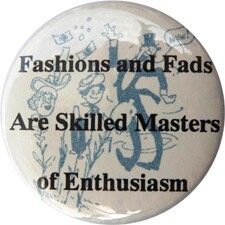Stock Market Video The Three Monsters Under Growth Investors’ Beds
In Case of Doubt Sound Convincing
Stock Market Video
Stock Market Video
The Comfort of Common Goals
Fashions and fads are skilled masters of enthusiasm
In Case You Missed It
---
In this week’s Stock Market Video, Cabot Market Letter editor Mike Cintolo notes that recent action from the Fed and the European Central Bank has pushed the markets into a higher gear. While it would have been better to get in when the market’s tone improved in August, there are still stocks that can be bought. Google (GOOG), Ebay (EBAY) and Apple (AAPL) are extended, but stocks like LinkedIn (LNKD), Michael Kors (KORS), Lululemon (LULU) and Under Armour (UA) are nicely set up or just out of bases. Commodity related stocks like Seadrill (SDRL) and Ensco (ESV) are also attractive, as is the SPDR Basic Materials Fund (XLB). Click below to watch the video!
The Comfort of Common Goals
I don’t have any historical data, but I know that the practice of senior corporate executives getting part of their compensation in company stock has been around for a long time.
Compensation in stock is a win/win on every imaginable level, but the biggest bonus, at least from the point of view of stock investors, is that the practice aligns the executive’s interests with those of the investor. A CEO with a lot of stock has a built-in reason for trying to increase the value of the stock. Every dollar the stock price appreciates is like getting a raise in pay, and if the exec chooses to hang on to them, the dividend income also boosts total pay.
But during the Tech Bubble days, when the future was so bright that you needed sunglasses to even think about it, the giving of stock options began to gather momentum.
Stock options—agreements to sell a specified number of shares to someone for a specified price at an unspecified future time—offered a way for a company with no money to give key players a lot of money, presumably some time in the future when the stock was trading way, way above its option price. Needless to say, many of those options wound up about as valuable as paper towels, but not as useful.
These days, both stock and stock options are a hellaciously popular part of compensation packages for senior executives, and the justification for granting them comes right back to the incentive they give for everyone to work hard to increase shareholder value. (And, in fact, I always like to see that the C-level officers in a company I’m considering have a significant equity stake.) It’s not that executives don’t always have shareholder value in mind when they make decisions, but it’s easier to really believe it when they’re shareholders themselves.
Small moral: In the same way that owning stock or stock options creates a strong connection between the fortunes of executives and interests of stockholders, Cabot’s way of doing business aligns our interests with those of our readers, which is you.
Here’s how that works.
Cabot publishes investing newsletters, and our revenue comes from paid subscriptions. We don’t accept paid advertising in our letters and we don’t put advertising on our website. We don’t accept fees from companies to promote their stocks. We don’t handle money for people. We’re a private company, so we don’t have stockholders to answer to.
What we have are subscribers, and they buy our newsletters and renew their subscriptions because they find them useful and they make money by following our advice.
If people don’t get value out of our newsletters, they don’t renew their subscriptions and we don’t stay in business. No amount of fanfare or sleight of hand can obscure that bottom line. If our subscribers make money, we get to keep doing what we do.
And that’s about as direct an alignment of interests as you’re likely to find anywhere.
And with all that said, here’s a little fanfare.
The Cabot Market Letter, which is our flagship publication, is now nearly 42 years old and still going strong. CML, as we call it, does what most stock gurus say can’t be done; it outperforms the broad market year after year.
Cabot Market Letter is a growth stock advisory that uses market timing to vary the amount of exposure that our subscribers have to the market. If markets are in a foul mood and stocks are trending down, CML’s editor Mike Cintolo tightens up the loss limits on the stocks in the Model Portfolio (which can have up to 12 stocks when it’s fully invested) and moves toward a higher cash position.
This shift in market exposure alone kept CML readers from tanking along with the market in 2008.
Mike’s stock picks are based on the strength of the stock’s chart (momentum), the attractiveness of the company’s story and the soundness of the underlying fundamentals like revenue, earnings and after-tax profit margins.
The Cabot Market Letter tells you exactly what’s going on in the market, what each buy and sell is, how our market timing indicators are faring, what stocks we have our eye on for future buying and, more importantly, how we think about growth investing.
Subscribers receive weekly messages, with regular issues and updates coming out on alternating Wednesdays. And occasionally, there’s news about a stock that needs buying or selling or something happening in the market that’s so urgent that we send out a special hotline message.
More than anything, after all my years in the investment industry, watching the cynicism and weariness of professional money managers, what impresses me about the Cabot Market Letter is the degree to which Mike really lives and dies by how the Letter is doing.
Tim Lutts and I also write part of each Letter, but it’s really Mike’s baby, and he’s as emotionally attached to the performance of the Cabot Market Letter as he is to the fortunes of the New England Patriots. And that’s a lot!
The final thing I have to say about the Cabot Market Letter is that it requires some commitment from its subscribers as well. You have to be prepared to follow the rules, including both the fun part (buying) and the sometimes not-so-fun part (selling).
If you let it, the Cabot Market Letter will change how you think about growth investing. And it will put you in sync with Mike Cintolo and the whole Cabot growth team.
I think it’s a good idea.
For more details on Cabot Market Letter, click here. ---
Here’s this week’s Contrary Opinion Button. Remember, you can always view all of the buttons by clicking here.
Fashions and Fads are Skilled Masters of Enthusiasm
Remember how excited investors were about Iomega? Taser? Crocs? Every one of these stocks had a huge bull run, as sales and earnings expanded and investors’ expectations of the future were ratcheted higher and higher. And every one of these stocks collapsed when investors realized their projections were overly optimistic, and that these fads, like others, would pass. The best growth stock investors are happy to ride the wave of fashion as it is building, but they’re quick to exit when the uptrend falters, knowing that enthusiasm can cool quickly.
[Editor’s Note: Enthusiasm is a loaded word for those who follow the market, usually denoting a phase when even non-investors are clambering into equities. When the last person jumps on the bandwagon, it’s all downhill from there.]
In case you didn’t get a chance to read all the issues of Cabot Wealth Advisory this week and want to catch up on any investing and stock tips you might have missed, there are links below to each issue.
Cabot Wealth Advisory 9/10/12—Expect the Unexpected
Lou Gagliardi, the energy guru who edits Cabot Global Energy Investor, writes in this issue about really unexpected events, the “black swans” that no one sees coming, and how to handle them. Stocks discussed: Seadrill (SDRL) and Pacific Drilling (PACD).
Cabot Wealth Advisory 9/11/12—How to Pick Good Stocks
In this issue, Tom Garrity, the tireless researcher behind Cabot Small-Cap Confidential, tells how he first became fascinated by stocks and how he goes about picking his little-known winners. Stock discussed: AuthenTec Inc. (AUTH).
Cabot Wealth Advisory 9/13/12—It’s All Psychology
Mike Cintolo, editor of Cabot Market Letter, argues in this issue that investors’ own psychology makes it hard to make money in the market, but that keeping a journal of your trades can help you improve your returns. Stock discussed: Ensco (ESV).
Have a great weekend,
Paul Goodwin
Editor of Cabot Wealth Advisory and Cabot China & Emerging Markets Report

